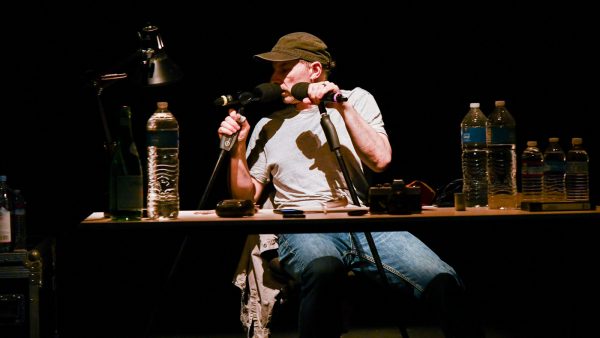[alert type=alert-white ]Please consider making a tax-deductible donation now so we can keep publishing strong creative voices.[/alert]
At the very least, Simon McBurney is a man who commands admiration. He is a founding member and Artistic Director of the noted British theatre company known as Complicite — a French word used in this instance without the usual accent aigu on the final e, so not sure how you pronounce it, although it is a perfect word for describing the complicit arrangement that is theatre: the engagement of performer and audience.
Complicite has existed for more than 30 years. Not unlike The Wooster Group, the company thrives on an iconoclastic experimental approach to performance that seeks out the unconventional, presenting it as subversively as possible, usually by integrating spoken text with other elements such as visuals, music, sound, imagery and technology. Aside from McBurney’s multiple personal achievements as a writer, filmmaker, theatre maker, performer and heaven knows what else, he possesses that physical quality writer Antonia Fraser once called “the magnetism of energy.” He is also offbeat, curious, prolific and ambitious, which means his choices can lead him into tricky situations.
I was going to say “lead him astray,” but that would be wrong. Choice is the exercise of personal will. In The Encounter, a very tricky show that McBurney has brought to The Wallis in Beverly Hills for a run that ends Sunday, he has taken an uncommon episode in the life of the late National Geographic photographer Loren McIntyre, as filtered through a book written by Petru Popescu (The Encounter: Amazon Beaming) and filtered it again in his script for the stage version. In case you’re not counting, that’s three filters between the event and the play.
In that rarefied atmosphere the stakes are high. You can succeed mightily or the reverse, with many possibilities in between. McBurney chooses to tell this tale of McIntyre’s encounter with the indigenous Mayoruna tribe of the Amazonian rainforest and how the experience of losing himself among them, after losing his way while chasing them — and losing all the props of his civilization along the way — alters not only his bearings, but also his entire concept of time, reality and other so-called norms of consciousness as he previously perceived them.

It is a harrowing, transformative story and the point of telling it is to explore the very nature of consciousness when its fallibilities are so radically exposed and there is a serious question of whether this man can ever return to being quite the same as he once was. Can he go back to life as he knew it in his previous universe? That involves re-examining profound philosophical and adaptive issues we all face, but choose not to question because we don’t have to. To say nothing of needing to re-evaluate his life against that of the tribe, which exists in a different but equally significant reality.
What this is really about is that “he encounters another narrative,” McBurney told a British interviewer. “I have no Rousseau-esque illusions that these people [the Mayoruna tribe] live better lives. The point is that their narrative is as important as ours.”

McBurney chose to make this a one-performer event, but, as he makes clear, it is not a one-man show. He has the assistance of a retinue of set, sound, lighting and projection designers, sound engineers and supervisors, and a large cast of recorded voices. He also chooses to perform it through yet another filter — filter number four: headphones that are provided at your seat and that speak to you in one ear or the other or both. As we, the members of the audience, are repeatedly admonished before the curtain goes up, you need to make sure the ear phones are working before the lights go down or you won’t be able to hear the play.
That did not seem to become a problem at the performance I attended. But the bigger question is why? Why the headphones? If they are intended to magnify the experience, the effect at the Wallis tended to be the reverse. They add yet an another barrier to the immediacy of the story. The injection of forest sounds or the buzzing of a mosquito, and short quotes from other people reflecting on the broader philosophical subject of consciousness, along with the sweet but disconnected interruptions of McBurney’s then-five-year-old daughter who can’t sleep while he’s working on his script, remain just that: interruptions.
Why also the extreme variations of consistently dark lighting? The stage is plunged in so much gloom and the speech sometimes drifts faint and hard to follow as it comes in through the headphones that, if anything, this combination incites you to close your eyes and wonder if this could not just as well be done as a radio play? So while the story captivates, the mode of delivery enervates. Like the rest of this uncommon performance, it leaves us with more questions about the wrong things than it delivers answers (or more questions) about any of the right ones.
Top image: Simon McBurney in The Encounter at The Wallis Annenberg Performing Arts Center in Beverly Hills.
All photos by Robert Latour.
WHAT: The Encounter.
WHERE: Wallis Annenberg Performing Arts Center, Bram Goldsmith Theatre, 9390 N. Santa Monica Blvd, Beverly Hills, CA, 90210.
WHEN: Today & Friday, 8pm; Saturday, 2 & 8pm; Sunday 2pm. Ends Sunday.
HOW: Tickets: $25-$100 (subject to change), available online at TheWallis.org/Encounter, by Phone 310.746.4000 or at the theatre box office.
